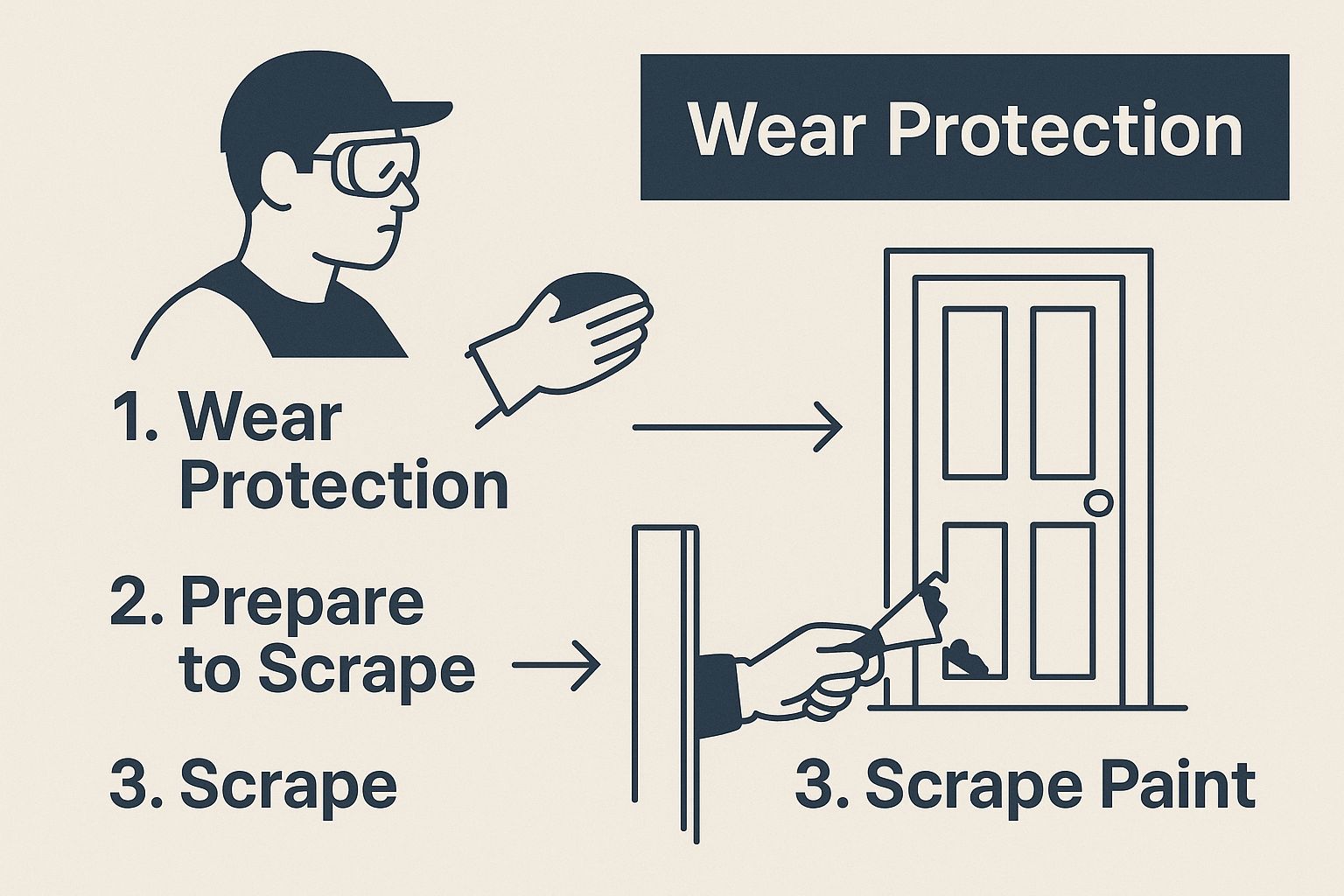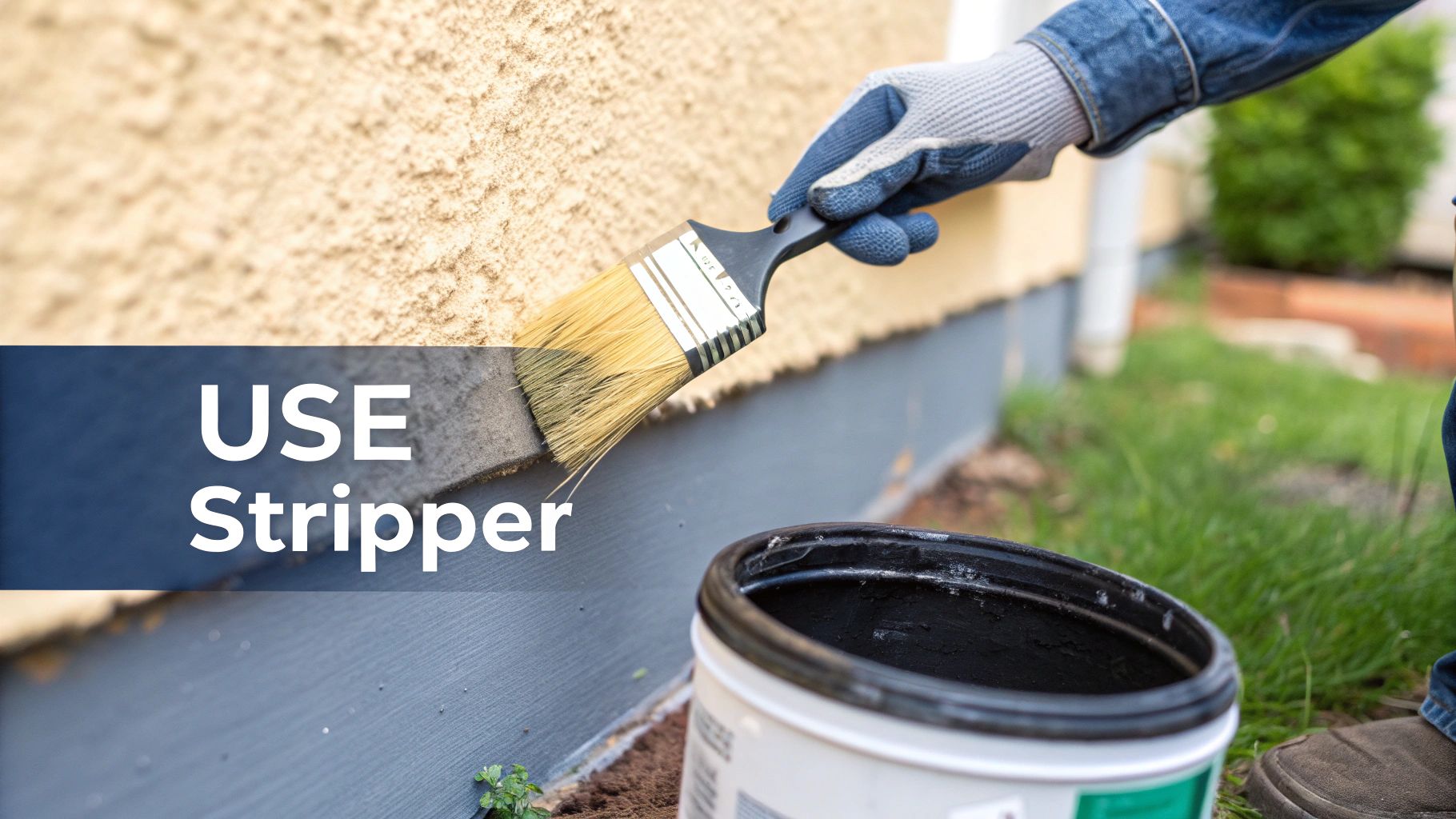How to Get Rid of Paint The Right Way in the UK

How to Get Rid of Paint The Right Way in the UK
Once the last coat of paint is on the walls and the project is finally done, you’re usually left with a small mountain of half-empty paint tins. It’s a familiar sight for any decorator. But what’s the right way to get rid of them?
How you tackle leftover paint all comes down to what kind it is. Water-based emulsions need to be completely dried out before you can bin them, whereas solvent-based glosses are classed as hazardous waste and need a special collection. Getting this one distinction right is the key to disposing of paint legally, safely, and without harming the environment.
Your Quick Guide to Paint Disposal
With the decorating finished, the question of what to do with the leftover paint quickly becomes a priority. This isn't just about freeing up space in the garage; chucking paint away incorrectly can contaminate the environment and even land you with a fine. This guide will walk you through the proper way to handle it from the get-go.
The type of paint you’ve used really does dictate everything. Here’s a quick rundown:
- Water-Based Paint (Emulsion): This is the stuff most of us use for walls and ceilings. If you only have a small amount left, you can let it dry out completely and then pop it in your general household bin.
- Solvent-Based Paint (Gloss, Satinwood): This is a different beast altogether. It’s officially hazardous waste, so it can never go in your household bin – not even when it’s dry. It has to be taken to a proper hazardous waste disposal site.
This isn’t just a small-scale problem. The amount of leftover paint in the UK is genuinely staggering. It's estimated that UK households are storing over 50 million litres of old paint, which is enough to give the Forth Rail Bridge a whopping 212 coats.
What’s more, research from the Royal Society of Chemistry revealed that 73% of UK adults confess to hoarding unused paint, and a huge chunk of that becomes unusable after just a few months of being stored incorrectly.
The Main Takeaway: The single most important thing you can do is figure out what type of paint you have. The easiest way is to check the cleaning instructions on the tin. If it says “clean brushes with water,” you’re dealing with a water-based paint. If it mentions white spirit or turpentine, it's solvent-based and needs to be handled with care.
How to Get Rid of Water-Based Paint
When you've finished decorating, you'll most likely be left with some water-based emulsion. It's the most common type of paint out there and, thankfully, the simplest to dispose of. How you go about it really just depends on how much you've got left in the tin.
The number one rule to remember is that you can never pour liquid paint down the drain or put it in your regular household waste. But for those last little dregs at the bottom of a can, the solution is easy: dry it out. Once the paint is completely solid, it's no longer considered hazardous liquid waste, and you can pop it straight into your rubbish bin.
What to Do with Small Amounts of Leftover Paint
Getting that last bit of paint to solidify is quicker than you might think. Just add something absorbent to the tin to speed things along.
- Cat Litter: Cheap, cheerful, and does the job brilliantly. Tip some in, give it a good stir until it's thick and clumpy, and then just leave the lid off.
- Sawdust: If you've been doing any other DIY, you might have some sawdust lying around. It works just as well – mix it in until all the moisture is absorbed.
- Paint Hardener: For a purpose-built solution, you can pick up a paint hardener from any DIY shop. These are designed specifically for this job and get to work very fast.
After you've mixed in your chosen material, find a well-ventilated spot for the tin – well away from kids and pets – and leave it until the contents are rock solid. This could take a few hours or a couple of days. You'll know it's ready when you can touch it and there's no liquid left at all.
Even when you're just prepping old paint for disposal, don't forget your personal protection. It’s always a good habit.

As this graphic shows, basic safety gear like gloves and goggles should be standard practice to protect you from any accidental splashes or fumes.
Dealing with Larger Quantities of Emulsion
If you're looking at a half-full or even a full tin of paint, trying to dry it out just isn't going to be practical. Your best bet here is to take it to your local Household Waste Recycling Centre (HWRC). We used to call them the 'tip', but these centres are now properly equipped to handle materials like paint and make sure it's dealt with correctly.
Before you load up the car, it’s a smart move to check your local council's website. Some recycling centres have specific drop-off points or rules for paint, and a quick online search can save you a wasted journey. And, of course, make sure every tin is sealed up tight to prevent any spills on the way.
A Quick Word of Warning: Please don't be tempted to pour water-based paint down the drain. It might seem harmless because it’s water-based, but it can still clog up pipes and add pollutants to our water system. For larger volumes, the HWRC is the only responsible choice.
Managing Hazardous Solvent-Based Paints
When you’re dealing with solvent-based paints – things like gloss, satinwood, or specialised primers – the disposal rules get a lot stricter. These materials are officially classified as hazardous waste, and for very good reason. Their chemical makeup means they can cause some serious environmental damage if they end up in landfill or our water systems.
Unlike water-based emulsions, you absolutely must not put these paints in your household bin, even if you’ve managed to dry them out. The solvents they contain are still harmful, so simply solidifying the paint isn’t a safe or legal solution. And pouring any amount down the drain is strictly illegal; it poses a direct threat to wildlife and the water treatment processes we all rely on.
Identifying and Storing Solvent Paints Safely
First things first, you need to be sure you're actually handling a solvent-based product. The easiest way to tell is to read the cleaning instructions on the tin itself. If it says you need white spirit or a similar chemical to clean your brushes, then you're holding a hazardous paint. A strong, chemical smell is another dead giveaway compared to the much milder odour of emulsions.
Once you know what you've got, storing it securely is the next crucial step until you can get rid of it properly.
- Make sure the lid is airtight. Hammer it down firmly to stop any fumes from escaping and prevent the paint from hardening up before its time.
- Store it upright and out of reach. A cool, dry place away from children, pets, and any source of heat or open flame is what you're looking for. A locked shed or garage is perfect.
- Check for leaks. Give the tin a quick once-over to make sure it isn’t damaged or rusting, as that could lead to a nasty, hazardous spill.
Getting the storage right keeps your home safe and ensures the paint is in a good state for the disposal team to handle. It's a simple bit of housekeeping that prevents a lot of unnecessary risk while you sort out the next steps.
Finding Your Local Hazardous Waste Service
The only correct way to dispose of solvent-based paint is through your local council's designated hazardous waste disposal service. Every council has a system in place for this, but the specifics can vary quite a bit from one area to another. This isn’t a one-size-fits-all process, so you’ll need to do a little local research.
A good starting point is your local council's website. Just search for "hazardous waste collection" or "paint disposal," and you should find a page with all the details you need. Some councils offer a free collection service right from your home, while others will ask you to take it to a specific drop-off point at a Household Waste Recycling Centre (HWRC).
It's absolutely vital to follow the official guidelines precisely. The regulations around hazardous waste are strict for a reason – they’re there to protect public health and the environment. Trying to cut corners can lead to fines and, more importantly, cause significant ecological harm.
For a deeper dive into your responsibilities, it's worth reading up on the UK's hazardous waste disposal regulations, which explain why these rules are so important.
Bear in mind that some HWRCs might only accept hazardous materials on certain days or may require you to book a slot in advance. Always check before you load up the car. Taking a few minutes to confirm the process will ensure you can dispose of your paint legally and with complete peace of mind.
Giving Leftover Paint a Second Life

Before you get ready to dispose of that leftover paint, it’s worth asking one simple question: is it still usable?
If the answer is yes, the most sustainable and community-minded option is to give it a second life. This isn't just about reducing waste; it’s about turning your leftovers into a valuable resource for someone else.
This approach is a key part of the circular economy, where we try to keep resources in use for as long as we possibly can. Instead of the old "make, use, dispose" model, reusing paint means it can benefit another person, cutting down the need for new products and easing the strain on our environment. You can get the full picture in our guide to the circular economy in waste management.
The sheer volume of leftover paint really brings home the need for reuse. In the UK, a staggering 55 million litres of decorative paint go unused every single year. To tackle this, industry-led schemes like PaintCare are aiming to dramatically increase how much paint gets reused or recycled, setting a target of 75% by 2030.
Is Your Paint Suitable for Donation?
For your paint to be accepted, it needs to be in a reasonable condition. Nobody can use a tin that’s hardened into a solid block or is full of contaminants. Before you start looking for a drop-off point, give your paint a quick check against these simple criteria.
- How much is left? The tin should be at least half-full. Most schemes need a decent amount to make the donation worthwhile.
- What's the condition like? Is the paint still liquid? If there’s a skin on top, you can often peel it back to find perfectly good paint underneath. But if it's lumpy, separated, or solid, it’s no good.
- Is it in the original tin? The paint needs to be in its original container with the label easy to read. This is crucial for identifying the paint type and any safety information.
Remember, you can't donate solvent-based or hazardous paints. These donation schemes are only for water-based paints, like the standard emulsions you'd use on your walls.
Finding a Home for Your Leftover Paint
The easiest way to pass on your usable paint is through a dedicated reuse network. The most well-known in the UK is Community RePaint, a fantastic scheme that’s been running since 1993. It collects reusable, leftover paint and gets it to individuals, families, and community groups at an affordable price.
Community RePaint has over 70 drop-off points nationwide, often found at your local Household Waste Recycling Centre (HWRC). Their website has a simple postcode locator to help you find your nearest one.
By donating, you ensure your paint goes towards brightening up a local school, a community hall, or a family’s new home. It’s a powerful and simple way to get rid of your old paint that benefits everyone involved.
Recycling Empty Paint Tins and Tubs

Once you've used, donated, or safely dealt with the liquid paint itself, you’re left holding the container. The job isn't quite done, because making sure the empty tin or tub is handled correctly is the final piece of the puzzle. This is often where people get stuck, but it’s a crucial step for managing waste responsibly.
What happens next to your empty paint container depends entirely on what it’s made of. Metal and plastic have very different journeys ahead of them.
Prepping Containers For Recycling
Whatever the material, the golden rule is that the container must be completely empty and bone dry. Any lingering wet paint can contaminate a whole batch of recycling, making it useless. It's why local councils are so strict about accepting them.
To get your containers ready, grab a spatula or a small scraper to get every last smear of paint out. Give the inside a good wipe with an old rag or some paper towel. After that, leave the lid off for a few days somewhere safe and well-ventilated to let any remaining film dry out completely.
Key Takeaway: A paint tin isn't really "empty" for recycling purposes until it's completely dry. If there's any liquid residue left, it’ll be rejected at the recycling centre and just end up in general waste.
The Reality Of Metal vs Plastic Recycling
When it comes to the chances of being recycled, there’s a big difference between metal and plastic paint containers. Metal tins are far more likely to be successfully turned into something new.
In fact, while metal paint cans are recycled at a relatively high rate of 65%, a tiny 9% of plastic paint containers actually make it through the process. There are pilot schemes looking into better ways to collect and clean plastic paint tubs to boost these numbers, but for now, metal is the more sustainable choice. You can learn more about managing paint containers from the experts at the Greenwashing Index.
This difference really highlights why preparing your tins properly is so important. By making sure your metal tins are clean and dry, you give them the best possible chance of being recycled.
Of course, this often raises the question of other disposal methods. While you can't put liquid paint in a hired skip, our guide on what can go in a skip explains that empty, dry metal containers are usually fine. Just be sure to double-check with your local council or waste provider first.
Common Paint Disposal Questions Answered
Even when you've got a solid plan, a few specific questions always seem to pop up when it's time to actually get rid of old paint. It’s easy to get bogged down in the details, worrying you'll make the wrong move. I've pulled together the most common queries I hear, with direct, no-nonsense answers to help you handle it all with confidence.
These are the usual sticking points, from what you can chuck in your household bin to what on earth to do when you're staring at a mountain of half-used tins. Getting these bits right is the key to a hassle-free clear-out.
Can I Put Dried Paint in My Regular Bin?
Yes, but there's a huge "if" attached: this only applies to water-based (emulsion) paint that has become completely solid. UK regulations are very clear that liquid paint is banned from landfill, which is why it absolutely must be fully hardened first.
The trick is to add something absorbent – think sand, sawdust, or even cat litter – directly into the tin. Give it a good stir, then leave the lid off in a well-ventilated spot until it's rock-solid. Once it's set, the paint is safe to go in with your general household waste.
But, and this is crucial, never try this with solvent-based paint. It’s classed as hazardous waste, wet or dry, and has to be taken to a proper facility.
What Is the Best Way to Dispose of Lots of Old Paint?
If you're dealing with a large amount of paint, like several full or half-full tins, trying to dry it all is just not practical. In this situation, your local council should be your first port of call. They'll give you clear instructions on what to do next.
Most councils will point you towards your nearest Household Waste Recycling Centre (HWRC), which will have a specific area for paint. Some might even offer a special collection service for big jobs, although you may have to pay a small fee for this.
Pro Tip: Before you do anything else, check if the paint is still good. If it is, the best thing you can do for the environment is to donate it. A brilliant scheme like Community RePaint will gladly take usable leftover paint and get it to local charities and community groups.
This approach doesn't just solve your storage problem; it turns your unwanted paint into a valuable resource for others.
How Do I Know if My Paint Is Water-Based or Solvent-Based?
Working out what type of paint you have is the most important step, but thankfully, it's usually pretty simple. The fastest way is to just read the cleaning instructions on the tin.
- Water-Based Paint: The label will say something along the lines of, "clean brushes with water."
- Solvent-Based Paint: The tin will tell you to use white spirit or another specialised brush cleaner.
If the label is long gone or too smeared to read, trust your nose. Solvent-based paints have that powerful, distinct chemical smell you can't miss. Water-based paints, on the other hand, are usually low-odour or have a much milder scent. This quick check will tell you exactly what you're dealing with.
Is It Illegal to Pour Paint Down the Drain in the UK?
Yes, it is completely illegal and incredibly damaging to the environment. This goes for both water-based and solvent-based paints. When you pour any paint down a sink or an outdoor drain, you're flushing harmful chemicals straight into our water system.
These chemicals can wreck the biological processes at wastewater treatment plants, stopping them from working properly. Worse, the pollutants can travel into rivers and oceans, poisoning aquatic life and harming wildlife. Always stick to the correct disposal methods – it keeps you on the right side of the law and helps protect the world around us.
For any project, from a small garden clear-out to a major renovation, managing your waste correctly is crucial. The Waste Group offers reliable and responsible skip hire across Dorset to make your job easier. With a price-match guarantee and a commitment to sustainability, we ensure your waste is handled professionally. Get an instant quote online today!
